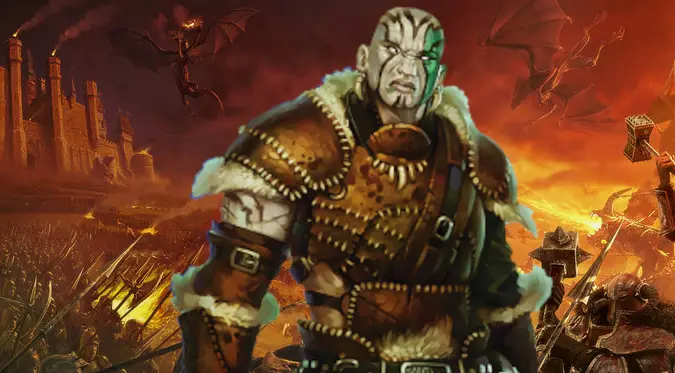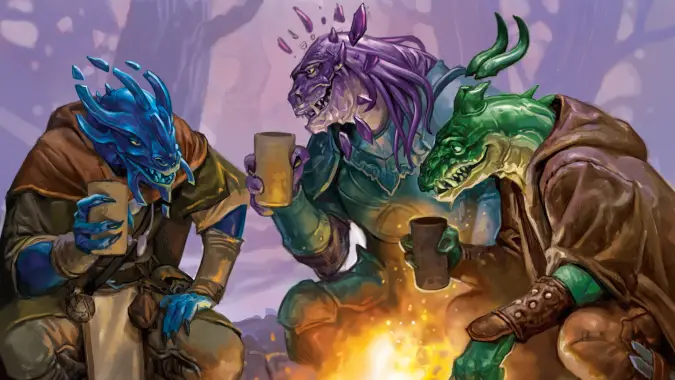One D&D playtest revision changes Aardlings, Dragonborn, and Goliaths Species (including how we’re not calling them Races anymore)

A big chunk of the latest One D&D playtest gameplay changes are to the Aardling, Dragonborn, and Goliath, which are emphatically not Races — because One D&D has also officially done away with the Race designation in favor of the Species label. As the One D&D playtest continues over at Unearthed Arcana the latest version can be found here and contains several revisions from the first playtest document.
The biggest change this round is the swap from Race to Species we mentioned above. For example, If you’re playing a Dwarf Fighter, instead of saying that your character’s Race is Dwarf, you’ll say their Species is Dwarf instead. This is a step other TTRPGs have taken in recent years as well, replacing Race with terms like Ancestry, Heritage, and so forth.
I’m not personally fond of calling them Species, because that doesn’t (to my mind) get far enough away from the term ‘Race’ and the biological essentialism it carries. Since this is a playtest and not yet completely codified as law, we get to leave feedback on that change, as well as these three new playable options. As such, my feedback is that I’d love to see them change it to something more like Origin, Ancestry, or Family Descent. Species feels too similar to Race for my comfort.
There are three Species that have been given a new design in this particular playtest document — the divine but bestial Aardling, the Dragon-descended Dragonborn, and the stoic giantkin Goliaths. So what are we getting with all three of these new Species in One D&D?

Aardlings are more emphatically beastlike, but Dragonborn aren’t much changed
An effort has been made in this iteration to make the Aardling stand out from the Aasimar of previous editions. We’ve also been told that the Aardling does not replace the Aasimar, which is welcome information. Looking over the Aardling, it’s still basically similar to its previous iteration. All Aardlings get Divine Magic options like the Thaumaturgy spell or other 0 level spells, chosen during every long rest and their Keen Senses let them gain Proficiency in the Perception skill.
You also get the head of a beast, and whatever divine beast you’re descended from grants you a variety of abilities. Several options are provided in the playtest.
- Climbers are descended from divine creatures like bears, cats, lizards, and squirrels. Their potential traits include hooked claws, sharp nails or long lizardlike tails. They get a climb speed and can increase Unarmed Strike damage once per turn by an amount equal to their Proficiency Bonus.
- Flyers are, well, Flyers — divine creatures like bats, eagles, owls, ravens and so on. It doesn’t say dragonflies but I don’t see why you couldn’t. Flyers have vestigial wings which they can use to glide when falling to avoid damage. You can also use the wings to get advantage on Jump checks.
- Racers are runners like deer, dogs, horses or Triceratops horridus. Amazingly, I’m not making that last one up, it’s in the playtest document. No, really! When Racers use the Dash action they add their Proficiency Bonus multiplied by 10 to their speed. So at 1st level, you’d add 20 to your speed, and at 20th level you’d add 60 feet.
- Swimmers like the water, and often have crocodile, dolphin, frog, or shark heads. These folks get Resistance to Cold Damage, a Swim speed, and can hold their breath for an hour.
Dragonborn are almost unchanged from the previous version, with some clarifications made as to when and how they can use their Breath Weapon — it’s now part of the Attack Action, replacing one of the attacks in that action. If you only have one attack per Attack Action, it’ll replace that one, but if you have Extra Attacks like a Fighter, you could use your Breath Weapon and then charge in and attack with your axe or sword.
Also, instead of the Draconic Language ability, which gave Dragonborn the ability to speak, read and write Draconic, at 5th level Dragonborn gain Draconic Flight. This ability allows them to take a Bonus Action and gain the ability to fly for 10 minutes unless they are Incapacitated or decide to retract their wings themselves. The wings that they use to fly with this ability appear to be made of the same element as their Breath Weapon and once used, they require a Long Rest to use again.

Goliaths are the Giant version of Dragonborn
Goliaths, on the other hand, had not yet appeared in the playtest at all, and so this is the first time we get to see a revised version of them. Their descent from the original Giants is emphasized here, including abilities to grow in size. One big change is that Goliaths are now broken up into sub-groups based on which kind of Giants they’re descended from — so the original version of Goliaths from 3rd edition D&D would be descendants of Stone Giants, but you could just as easily be descended from Fire, Frost, Storm, Cloud or Hill Giants instead, with different abilities granted by your Giant ancestry.
Goliaths can now use Large Form, allowing them to gain the ability to grow to Large size at 5th level, which lasts for 10 minutes and gives advantage on Strength checks and 10 feet of speed. You can only do this once per long rest.
Powerful Build gives Advantage on Saving Throws to end the Grappled condition and counts you as one Size larger (so Large for a normal Goliath and Huge for a Goliath using Large Formor other size changing abilities) when determining your carrying capacity and the weight you can push, drag or life.
Abilities they have in current D&D 5e are replaced by their various Giant Ancestries as follows. You choose one of them on character creation. All of these abilities refresh on a long rest and gain as many uses per long rest as your Proficiency Bonus.
- Cloud’s Jaunt comes from a Cloud Giant ancestry, and it lets you magically teleport up to 30 feet as a Bonus Action to any place you can see.
- Fire’s Burn comes from the blood of Fire Giants, and it lets you add 1d10 fire damage to a successful attack that deals damage.
- Frost’s Chill indicates you have a Frost Giant somewhere back there in your bloodline. It’s similar to Fire’s Burn, but instead you can add 1d6 Cold damage to an attack and also reduce that target’s Speed by 10 feet until the start of your next turn.
- Hill’s Tumble calls upon the power of Hill Giants in your blood. When you hit a Large or smaller creature with an Attack Roll and deal damage, you can knock that target Prone.
- Stone’s Endurance, which Goliath’s currently have in 5e, is now the ability gained from Stone Giant forebears. When you take damage, you can spend your Reaction and roll a d12, adding your Con bonus to the roll. That’s the amount of damage you subtract from the roll. Imagine a level 20 Goliath Barbarian able to roll 1d12 + 6 to reduce damage during a Rage? And being able to do that six times? It’s a very strong ability still.
- Storm’s Thunder is the power of the Storm Giants, and it’s similar to abilities like Hellish Rebuke. If you take damage from a creature within 60 feet, you can use your Reaction to deal 1d8 Thunder damage back.
In other words, Goliaths now perform a similar role to the Dragonborn, but for Giants instead of Dragons — they’re a playable race that lets you tap into these iconic D&D entities’ incomprehensible power.
I’m interested in seeing how other Species (though I’m still hoping for a revision to Origin) end up changing over the course of the Playtest. So far I really like the Goliath and think the Dragonborn and Aardling have some potential, but could use some more iteration.
Please consider supporting our Patreon!
Join the Discussion
Blizzard Watch is a safe space for all readers. By leaving comments on this site you agree to follow our commenting and community guidelines.
 @MatthewWRossi
@MatthewWRossi




